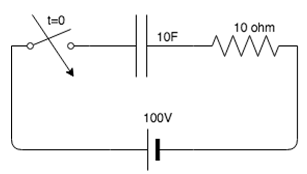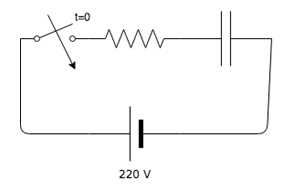This set of Basic Electrical Engineering Multiple Choice Questions & Answers (MCQs) focuses on “Transients in CR Networks”.
1. A CR network is one which consists of _________
a) A capacitor and resistor connected in parallel
b) A capacitor and resistor connected in series
c) A network consisting of a capacitor only
d) A network consisting of a resistor only
View Answer
Explanation: A CR network is one which consists of a capacitor connected in series with a resistor. The capacitor discharges or charges through the resistor.
2. At DC, capacitor acts as _________
a) Open circuit
b) Short circuit
c) Resistor
d) Inductor
View Answer
Explanation: Capacitive Reactance XC = 1/(2πfC)
For DC, f=0 so, XC becomes infinite. Hence for dc, the capacitor acts as an open circuit.
3. In an RC series circuit, when the switch is closed and the circuit is complete, what is the response?
a) Response does not vary with time
b) Decays with time
c) Increases with time
d) First increases, then decrease
View Answer
Explanation: In an RC series circuit, the response decays with time because according to the equation, there is an exponential decrease in the response.
4. If the switch is closed at t=0, what is the current in the circuit?

a) 0A
b) 10A
c) 20A
d) Infinity
View Answer
Explanation: As soon as the switch is closed at t=0, the capacitor acts as a short circuit. The current in the circuit is:
I=V/R = 100/10 = 10A.
5. Calculate the voltage across the capacitor at t=0.

a) 0V
b) 10V
c) 20V
d) Infinity
View Answer
Explanation: When the switch is closed at t=0, the capacitor has no voltage across it since it has not been charged. The capacitor acts as a short circuit and the voltage across it is zero.
6. Calculate di(0)/dt if the switch is closed at t=0.

a) -9.9A/s
b) -10A/s
c) 0A/s
d) -0.1A/s
View Answer
Explanation: Applying KVL to the given circuit, we get:
i=i0e-t/RC = (100/10)e-t/100
i=10 e-t/100
di/dt = -(10/100) e-t/100
di(0)/dt=-0.1A/s.
7. Calculate d2i(0)/dt2 from the given circuit.

a) 10-6A/s2
b) 10-3A/s2
c) 106A/s2
d) 103A/s2
View Answer
Explanation: Applying KVL to the given circuit, we get:
100+10i(0)+1/10*integral(i(0)dt)=0
Differentiating once, we get:
10di(0)/dt+1/10*i.
Differentiating once again, we get:
10d2i(0)/dt2+10di(0)/dt=0.
Substituting the values of di/dt from the previous explanation, we get d2i(0)/dt2=10-3A/s2.
8. The current equation for the given circuit is?

a) i=10e(-0.01)t A
b) i=10e(0.01)t A
c) i=10e(-0.001)t A
d) i=100e(-0.01)t A
View Answer
Explanation: The KVL equation is:
100+10i(0)+1/10*integral(i(0)dt)=0
On applying Laplace transform to this equation, we get:
100/s=I(s)/10s+10I(s)
Solving the equation, we get:
i=10e(-0.01)t A.
9. The expression for the current in an RC circuit is?
a) i=(V/R)et/RC
b) i=(V/R)e-t/RC
c) i=(V/R)(1-e-t/RC)
d) i=(V/R) (1-et/RC)
View Answer
Explanation: Applying KVL to the given circuit, we get:
i=i0e-t/RC = (100/10)e-t/100
i=10 e-t/100.
10. What is the voltage in the resistor as soon as the switch is closed at t=0.

a) 0V
b) Infinity
c) 220V
d) Insufficient information provided
View Answer
Explanation: As soon as the switch is closed at t=0, there is no charge in the capacitor, hence the voltage across the capacitor is zero and all the 220V voltage is the voltage across the resistor.
Sanfoundry Global Education & Learning Series – Basic Electrical Engineering.
To practice all areas of Basic Electrical Engineering, here is complete set of 1000+ Multiple Choice Questions and Answers.
If you find a mistake in question / option / answer, kindly take a screenshot and email to [email protected]
